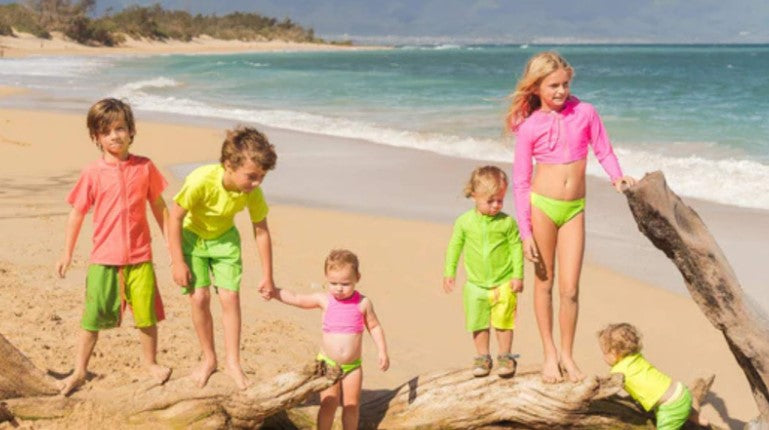
Are pink swimsuits safe?
Parents know that swimsuit color affects water safety. Pink swimsuits might look cute on the beach, but are they safe in the water? Certain bright pink shades can make your little ones more visible, while you should avoid dark shades.
Quick links:
Why swimsuit color matters for safety
How visible are pink swimsuits underwater?
How do different shades of pink perform in water?
How water conditions affect pink swimsuit visibility
High visibility alternatives to pink swimwear
Let's find out if pink swimsuits protect your children or put them at risk.
Why swimsuit color matters for safety
Darker colors absorb light, which causes swimmers to disappear below the surface. The contrast between swimwear and water determines visibility. Brighter colors stand out while darker shades blend in.
Parents or lifeguards need to be able to locate children quickly in crowded pools or at beaches. Drowning is the leading cause of accidental death for children ages 1–4.
Bright swimsuit colors reflect more light. Neon yellow, orange, and bright pink are visible at greater underwater distances than navy or black.
How visible are pink swimsuits underwater?
Water absorbs color as depth increases. Most colors look blue or violet when submerged more than a few feet underwater, which reduces visibility.
Pink contains red and white pigment, which means pink swimsuits appear blue or white beyond 5–10 feet deep. The red components of pink disappear first, leaving a pale, washed-out appearance that blends with the surrounding water. Fortunately, most pools are shallow enough for you to see pink even if your children dive to the bottom. Natural water is another story.
Cloudy skies, choppy surfaces, or murky water make pink swimwear harder to spot from above the surface, exactly when visibility matters most. Avoid letting children play in the water during bad weather or water conditions.
How do different shades of pink perform in water?
|
Visibility at 3–5 ft |
Visibility at 10–15 ft |
Best for |
|
|
Light pink |
Good |
Poor |
Shallow pools, close supervision |
|
Dark pink |
Fair |
Poor |
Stylish lounging |
|
Neon pink |
Excellent |
Fair |
Most swimming environments |
|
Pink with patterns |
Good |
Poor |
Shallow water, family photos |
SwimZip offers neon swimwear in bright pink. These eye-catching designs improve swimmer visibility and look stylish.
How do water conditions affect pink swimsuit visibility?
Water conditions impact swimsuit visibility regardless of color. Even neon pink suits become difficult to spot in some environments.
-
Pools: Chlorinated pools with clear water provide excellent visibility for pink swimwear. The controlled environment and often white or light blue pool floors create better contrast.
-
Oceans: Saltwater alters how pink appears underwater. Pink swimsuits fade quickly in ocean environments, particularly beyond shallow areas.
-
Lakes: Natural sediment and plant material in lakes reduce underwater visibility. Pink swimwear loses its vibrant color, especially in deeper sections.
-
Murky water: Any water with high sediment levels, algae blooms, or stirred-up sand drastically reduces the visibility of all swimwear colors, including pink.
-
Light conditions: Direct overhead sun creates better visibility than low-light conditions at dawn or dusk. Cloudy days reduce underwater contrast for pink swimwear.
-
Water movement: Choppy water, waves, or churning swimming pools make pink swimsuits harder to see underwater.
Other high-visibility alternatives to pink swimwear
Neon pink swimsuits are easy to spot in most situations, but other shades of pink aren't your best options. Here are some colors you can try for maximum visibility:
-
Other neon colors (particularly neon orange, green, and yellow) create maximum underwater visibility through strong contrast against water. These bright fluorescent colors reflect more light and remain visible from greater distances than standard pink swimwear.
-
Bright blue swimwear stands out in both pool and natural water environments. Blue is visible in deeper water, though this doesn't necessarily increase visibility in all conditions.
-
Bright green swimwear offers similar benefits to blue. The color penetrates water effectively but may blend with algae in some natural settings.
-
Yellow maintains its visibility in pools and natural aquatic environments. This color works well in varied lighting conditions and water clarity levels.
SwimZip's high-visibility swimwear collection addresses safety concerns without sacrificing style. Our UPF 50+ fabric blocks harmful UV rays, and the bright colors in our neon swimsuit collection keep swimmers visible to lifeguards, parents, and other water users.
Shop SwimZip swimwear
SwimZip creates swimwear focused on style and safety. If you love pink but want better visibility, try our neon pink options with bright accent colors. These show up better underwater without sacrificing your style. All our swimwear includes UPF 50+ sun protection that blocks 98% of harmful sun exposure.
Browse our sun-protective swimwear for safe, stylish selections the whole family will love.
Pink swimwear safety FAQ
What are some water safety practices for kids?
Follow these aquatic safety tips to keep your kids safe during water activities:
-
Start swim lessons early to teach basic swimming skills.
-
Use Coast Guard-approved life jackets for non-swimmers.
-
Never leave children unattended around water.
-
Listen to all safety instructions from lifeguards and swimming instructors.
-
Assign a dedicated water watcher when multiple adults supervise.
-
Create and enforce consistent pool rules for all children.
-
Check depth before swimming.
What are the safest colors for swimming?
Neon-colored swimsuits provide maximum underwater visibility. For instance, bright orange creates a strong contrast against water, and neon green and yellow remain visible at greater depths than other colors. Light colors such as white also stand out well underwater, especially in deeper water.
Should experienced swimmers wear bright swimsuits?
Bright swimsuits are important for swimmers of all skill levels. Even experienced swimmers face cramps, collisions, or medical events underwater. Bright, high-visibility colors aid rescue efforts regardless of swimming ability. Parents should prioritize visibility for children, but adults should also choose safety over fashion when selecting swimwear.
How do environmental factors affect swimsuit visibility?
Water clarity, sunlight penetration, bottom surface color, and depth determine how well a swimsuit color performs underwater. Natural water bodies with vegetation, sediment, or tannins reduce visibility more than clear pools. Clouds and light angles can reduce water visibility within minutes.
Why is black swimwear so popular despite poor visibility?
Black swimwear remains popular for its slimming visual effect and fashion versatility despite being one of the worst colors for underwater visibility. Black absorbs rather than reflects light, so swimmers are nearly invisible beyond shallow depths. Many people prioritize appearance over safety when selecting swimwear. If you prefer dark colors, choose options with bright accents or trim to improve visibility without sacrificing style.
What is meant by 'layers of protection' for water safety?
Water safety experts recommend multiple layers of protection to prevent drowning incidents. Visible swimwear is one layer of protection alongside barriers (fences, covers), alarms, swimming skills, and effective supervision. Think of each layer as a backup for the others. For example, hi-vis swimwear options support adult supervision by making children easier to spot.
Further reading
What swimsuit colors should you avoid for kids?
What is the best swimsuit color to wear in the swimming pool?



Leave a comment
This site is protected by hCaptcha and the hCaptcha Privacy Policy and Terms of Service apply.